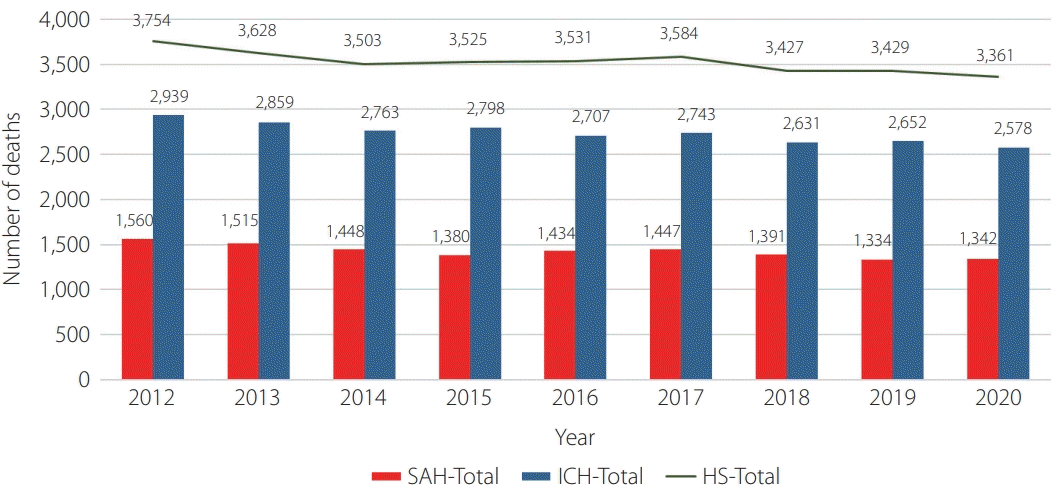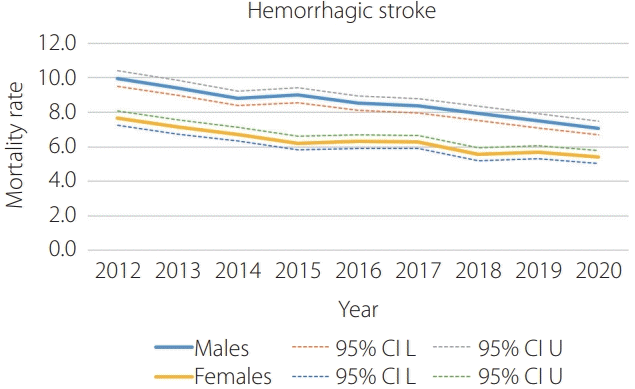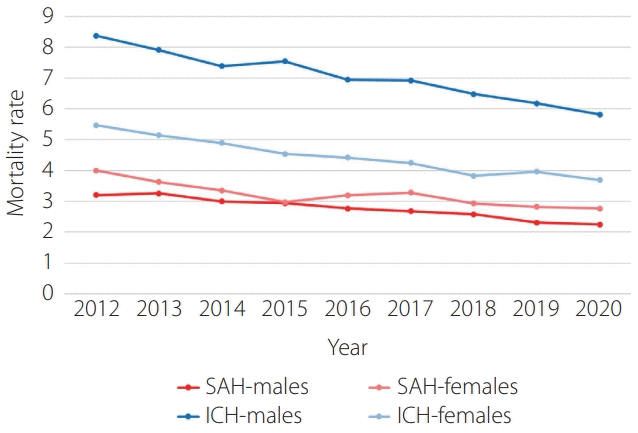1. Deaton C, Froelicher ES, Wu LH, Ho C, Shishani K, Jaarsma T. The global burden of cardiovascular disease. Eur J Cardiovasc Nurs. 2011; 10 Suppl 2:S5–S13.

2. Feigin VL, Lawes CM, Bennett DA, Anderson CS. Stroke epidemiology: a review of population-based studies of incidence, prevalence, and case-fatality in the late 20th century. Lancet Neurol. 2003; 2:43–53.

3. Sarti C, Rastenyte D, Cepaitis Z, Tuomilehto J. International trends in mortality from stroke, 1968 to 1994. Stroke. 2000; 31:1588–1601.

4. Kunst AE, Amiri M, Janssen F. The decline in stroke mortality: exploration of future trends in 7 Western European countries. Stroke. 2011; 42:2126–2130.
5. Pham TM, Fujino Y, Kubo T, Murata A, Le DC, Ozasa K, et al. Premature mortality due to stroke and trend in stroke mortality in Japan (1980-2005). Eur J Public Health. 2011; 21:609–612.

6. Lee SW, Kim HC, Lee HS, Suh I. Thirty-year trends in mortality from cerebrovascular diseases in Korea. Korean Circ J. 2016; 46:507–514.

7. Harmsen P, Tsipogianni A, Wilhelmsen L. Stroke incidence rates were unchanged, while fatality rates declined, during 1971-1987 in Göteborg, Sweden. Stroke. 1992; 23:1410–1415.

8. Hong KS, Bang OY, Kang DW, Yu KH, Bae HJ, Lee JS, et al. Stroke statistics in Korea: part I. Epidemiology and risk factors: a report from the Korean Stroke Society and Clinical Research Center For Stroke. J Stroke. 2013; 15:2–20.

9. Lee EJ, Lee HJ, Hyun MK, Choi JE, Kim JH, Lee NR, et al. Rupture rate for patients with untreated unruptured intracranial aneurysms in South Korea during 2006-2009. J Neurosurg. 2012; 117:53–59.

10. Lee SU, Kim T, Kwon OK, Bang JS, Ban SP, Byoun HS, et al. Trends in the incidence and treatment of cerebrovascular diseases in Korea: part II. Cerebral infarction, cerebral arterial stenosis, and Moyamoya disease. J Korean Neurosurg Soc. 2020; 63:69–79.

11. Lee JH, Yang DH, Park HS, Cho Y, Jun JE, Park WH, HYpertension-Diabetes Daegu Initiative Study Investigators, et al. Incidence of hypertension in Korea: 5-year follow-up study. J Korean Med Sci. 2011; 26:1286–1292.

12. Avezum Á, Costa-Filho FF, Pieri A, Martins SO, Marin-Neto JA. Stroke in Latin America: burden of disease and opportunities for prevention. Glob Heart. 2015; 10:323–331.

13. Cruz C, Campuzano-Rincón JC, Calleja-Castillo JM, Hernández-Álvarez A, Parra MD, Moreno-Macias H, et al. Temporal trends in mortality from ischemic and hemorrhagic stroke in Mexico, 1980-2012. J Stroke Cerebrovasc Dis. 2017; 26:725–732.

14. Sarti C, Stegmayr B, Tolonen H, Mähönen M, Tuomilehto J, Asplund K; WHO MONICA Project. Are changes in mortality from stroke caused by changes in stroke event rates or case fatality? Results from the WHO MONICA project. Stroke. 2003; 34:1833–1840.

15. Bajaj A, Schernhammer ES, Haidinger G, Waldhör T. Trends in mortality from stroke in Austria, 1980-2008. Wien Klin Wochenschr. 2010; 122:346–353.

16. Lotufo PA, Goulart AC, Fernandes TG, Benseñor IM. A reappraisal of stroke mortality trends in Brazil (1979-2009). Int J Stroke. 2013; 8:155–163.

17. Haast RA, Gustafson DR, Kiliaan AJ. Sex differences in stroke. J Cereb Blood Flow Metab. 2012; 32:2100–2107.

18. Reeves MJ, Bushnell CD, Howard G, Gargano JW, Duncan PW, Lynch G, et al. Sex differences in stroke: epidemiology, clinical presentation, medical care, and outcomes. Lancet Neurol. 2008; 7:915–926.






